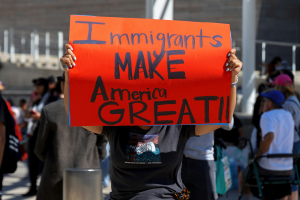“I attended Mother McAuley as a white student from Mount Greenwood. Issues surrounding race didn’t affect me. Today, I have Hispanic daughters who attend McAuley 30 years later. They see the school and policies very differently than I did. Unfortunately, it wasn’t better back then either. I just didn’t see it because it didn’t affect me.”
The above quote came from a survey distributed to alumnae of Mother McAuley Liberal Arts High School after the murder of George Floyd in May 2020. Seventy-seven percent of the 400 survey respondents believe that racism is a problem in the school’s community. Eighty-one percent of Black survey respondents stated that they are not confident McAuley would handle issues of discrimination appropriately. Others listed slurs and examples of microaggressions that they experienced regularly from students, faculty, and administration during their time at McAuley.
We asked the school for transparency and a statement of support for those affected by racism.
The survey’s distribution was prompted by stories of racism at the high school on the South Side of Chicago that began flooding alumnae social media pages after Floyd’s murder. I wasn’t shocked. I’ve taught in several other Catholic schools in Chicago, and the stories of these women sounded similar to what my students speak out about. But as an alumna of McAuley, the largest all-girls school in the country, and an admirer of Catherine McAuley—the foundress of the Sisters of Mercy of the Americas after whom the school is named—I’m disappointed an institution that repeatedly highlights McAuley’s care for marginalized women in its curriculum would act so glaringly out of line with her legacy.
As the parent quoted in the alumnae survey, the inconsistencies between the school’s actual environment and the legacy of Catherine’s mission mainly went unnoticed by me as a student. Growing up, I was primarily surrounded by people like me—white, Irish, and Catholic. My large Catholic grammar school lacked diversity. So when I began my freshman year at McAuley and my classes included a few students who were not white, I thought that was a diverse setting. I learned about justice issues, and my teachers used diverse texts and voices in class.
Still, a sprinkle of diversity at that point in my life was the most diverse academic setting many of my white peers and I had ever experienced. Unfortunately, I didn’t have the critical lens to see how systemic racism was affecting the experience. It wasn’t until later in life that I learned the vital tools needed to unpack systems of injustice and white supremacy around me.
As the whole nation became more aware of the systemic racism that shapes our culture, McAuley alumnae and students continued to speak out about racism in the school’s halls. When other organizations and schools, especially faith-based ones, released statements of support for anti-racism work last summer, McAuley’s administration did not comment. As the Sisters of Mercy used social media to voice concern about police brutality and acts of systemic racism, the high school still stayed silent.
Alumnae shared a feeling of deep disappointment in the institution not living up to the charism of the Sisters of Mercy and Catherine’s legacy. But instead of cutting ties with McAuley, they harnessed what they had learned there about working for justice and standing up for human dignity to hold the institution accountable to its own mission.
Alumnae in action
The “Macs for Justice” group formed to address the disparities between the spirituality and charism of the Sisters of Mercy and the reality at McAuley. More than 1,500 alumnae from the classes of 1960 to 2021, including myself, signed a letter addressed to the school’s administration and board of trustees. The letter expressed “disappointment and concern” for how the school was handling racism. It admonished the school to “acknowledge the current trauma of the situation, support your black students, and call for action against injustice” instead of relying on “vague platitudes” that “blatantly ignore the violence against black people taking place in this country on a near daily basis.” The letter also suggested that the school’s leaders were out of touch with the reality of many of their students.
Additionally, we asked the school for transparency and a statement of support for those affected by racism. After the letter was released, a network of 3,000 alumnae and former faculty and staff signed up to receive updates on the progress of “Macs for Justice.”
Next, we organized a sit-in at the high school campus. McAuley president Mary Klingenberger appealed for “collaboration” with the group, which turned the sit-in into a prayer service in the school’s parking lot. Yet we were looking for more than a prayer service. We wanted clear statements about what would change for current and future students.
I was part of a small group of women with experience in education and grassroots organizing who called for meetings with Klingenberger and McAuley principal Eileen Boyce O’Reilly. During these meetings, someone suggested antibias training for faculty and staff or rewritten school policies addressing discrimination, slurs, and use of microaggressions in the classroom. The administration, staff, and board members in attendance, however, were quick to come up with excuses for why those actions could not be done, even though they were given examples and contact references from other Chicago schools to use as resources. As a result, very little has been done to address racism at the school.
The school did allow a Black Student Union to begin meeting, but it is unclear how Black students are centered as this group is coled by a white student and moderated by a white teacher. As a white high school teacher working with a predominately white faculty myself, I understand that allies step up in situations where there is no one else to do so. However, McAuley continues to have trouble maintaining a diverse faculty and staff.
McAuley thrives on the idea that representation and empowerment are essential for girls, but the school only provides that representation for some of its students. “Macs for Justice” presented a short list of recommendations for the school that includes: formalize an alumnae/student/faculty working group; devise clear written policies for incident responses and a diversity, equity, and inclusion statement; continue to communicate about initiatives with alumnae; be transparent; educate and train faculty, staff, and students; adopt hiring and retention practices for employees of color; and support current students of color. The 2021–22 school year promises a complete student and staff presence on campus after a year with pandemic restrictions, allowing for more space to address some of these systemic issues. “Macs for Justice” plans to call for more meetings with the school and alumnae base.
Charism of inclusion
My collegiate alma mater has faced similar challenges in living up to its charism of justice. In 2019 the campus ministry at Saint Mary’s University of Minnesota (SMU) planned an immersion trip to visit the Br. David Darst Center in Chicago, a trip that had taken place in the past. Both SMU and the Darst Center are Lasallian institutions, laying a solid foundation for collaboration. But some staff at SMU expressed concern when the Darst Center asked people for their names and pronouns, a practice that doesn’t assume someone’s gender identity based on appearance. The trip was canceled as a result.
Students expressed their concerns about the cancelation with a protest on campus. Alumni wrote and delivered a signed letter to the board, local Winona press, and the school administration. They used the Lasallian charism to explain why the trip’s cancelation was problematic for students who are part of the LGBTQ community: “Listening to those who feel unheard in the community is an important part of Saint Mary’s Lasallian Catholic identity and is in alignment with the Lasallian Core Principles of ‘Respect for All Persons,’ ‘Inclusive Community,’ and ‘Concern for the Poor and Social Justice.’ ”
Institutions comprise people, so there is always the possibility of change.
Advertisement
SMU president Father James P. Burns and the board of trustees quickly responded to student and alumni groups. In a letter to the community, Burns responded, “It is true that Saint Mary’s, as a Lasallian Catholic university, has faced challenges in a full expression of its vision to welcome and embrace all people of good will. We have stumbled at times. But each time we stumble, we learn: we listen and try to improve in all areas.”
This past spring I was disheartened to hear that the officer involved in the shooting of Daunte Wright in Brooklyn Center, Minnesota, is an SMU alumna. Burns released another well-meaning letter to the community, but the letter didn’t mention the connection to Kimberly Potter (who resigned from the Brooklyn Center police department after the shooting). Students and faculty at SMU again demonstrated in response, hoping to start a conversation about accountability, diversity, and inclusion in a very white community. “We all kind of felt that we wanted the letter to denounce Kim Potter, mainly because we felt that she did not represent our Lasallian values and Saint Mary’s tradition,” Sexuality and Gender Alliance executive member and senior psychology major Denise Quizhpi told the Winona Post.
After that, SMU created a position for a vice president of inclusion and human dignity. Leon Dixon filled this role on June 1, 2021. As an alumna, I’m thrilled that SMU is taking this initiative to have an administrator and public-facing role with the responsibility of helping direct efforts of diversity and inclusion. However, the creation of this position is only the beginning. In higher education settings, students don’t often interface with administration in collaborative ways, and the real work of bringing change to campus culture will be a challenge. Yet I remain hopeful that this small step will encourage growth for faculty, staff, and students and prove to be more than a performative action on the part of the university.
Breaking point or strong bond?
Is there a point when we recognize that the institutions we love are fostering racism and there’s nothing we can do about it? Should we resign our efforts and walk away from the communities that once meant so much to us? The answer to those questions for me is no, even when it’s frustrating.
During a study abroad program as a student at SMU, I took a morning away from classmates to trek across Dublin to the Mercy International Centre, the motherhouse of the Sisters of Mercy and the burial site of Catherine. Conversation, tea, and prayer with the sisters who lived at the site of this personal pilgrimage connected me with my Mercy roots and reminded me of the strong bond among Mercy-educated women. Everywhere I travel and everywhere I work, I find a McAuley girl. We are a large, proud bunch. Each of us can tell the story of the fierce woman of faith who changed the lives of young women in Dublin many years ago. This woman continues to change lives today by inspiring those who follow in her footsteps to serve others by working for justice while holding the hands of the oppressed.
Institutions comprise people, so there is always the possibility of change. My Catholic education is part of why I’m so passionate about justice, antiracism, and nonviolence. I owe it to the current students and founding leaders who continue to do this work, especially as a person who benefited from those systems. In my time as a student, I was empowered to use my voice in the service of others, for justice, and in solidarity with my sisters. I take it personally that the institutions I credit for those skills are not doing those same actions for all of their students today.
We are slowly learning how to hold authority and institutions more accountable to live up to the missions they espouse.
McAuley and SMU are institutions that shaped who I am, and I want to continue to be proud to call them my home. Change and growth can happen in many ways, especially if community members call for the change.
Over the last year, many schools have faced the reality that their students are dealing with microaggressions and racism in the hallways, in the classroom, on athletic fields, and during extracurricular activities. Social media is a tool for students to share these narratives and draw attention to their experiences. These public-facing pages force many schools to pay attention and take a deeper look at how racism is being handled at their own institutions. It is easy to think that one voice or experience won’t make a difference, but history has shown us otherwise.
As a country and as a church, we are slowly learning how to hold authority and institutions more accountable to live up to the missions they espouse. Here are some suggestions for how to effect meaningful change in your institutions too.
Find strength in numbers. Unless you’re a major donor to the institution, it’s easy for one letter, email, or phone call to be dismissed. If you’re moved by something, others are too! Find them and approach the institution together.
Engage with the mission of the organization. Sometimes a reminder of the mission, charism, values, or principles of the organization can bring leaders to pause. It also reinforces that the group approaching leadership cares about the institution enough to start a dialogue with a shared language that all parties can understand.
Set clear ‘asks’ or goals. Constructive criticism is best received when met with actionable items. Dream big but keep the list attainable. This work is never done but must start somewhere. Giving the organization an idea of what the group wants to see is a helpful start and a great way to measure growth and follow through.
Create surveys. Numbers talk. Unfortunately, it’s easy for narratives of experience to get ignored. But when numbers accompany those narratives, it makes the issues more apparent. Polling current, past, and present community members also allows for more voices to be heard. Some people may answer a survey question but not feel comfortable coming forward on their own.
Take many routes. Addressing the institution’s leaders is essential but can also be a dead end if those leaders are part of the systemic issue. Look for other people to share the information with. In the case of “Macs for Justice,” we held a virtual update where we shared the nature of our conversations with the administration thus far. This brought us more volunteers and connections.
Use the media. Social media and local media outlets are great avenues for drawing attention to accountability issues. In both of the examples above, I was made aware of the letters being sent to the schools through my social media connections. “Macs for Justice” continues to update followers and gather support using social media.
This article also appears in the October 2021 issue of U.S. Catholic (Vol. 86, No. 10, pages 21-24). Click here to subscribe to the magazine.
Image: Unsplash/uuuuuutopia















Add comment